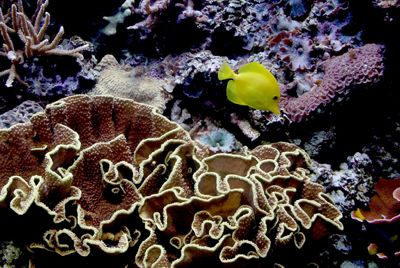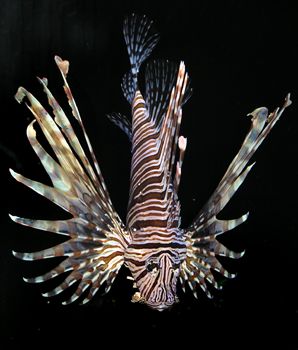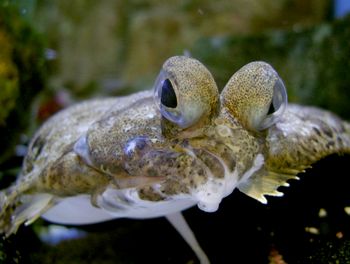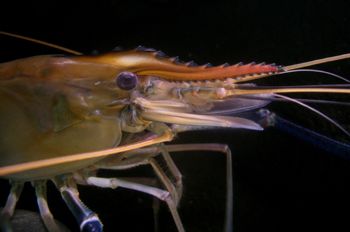
 While reading a photography magazine, I ran across a short article about taking photos in public aquariums. Now that is something that I really like to do, so I eagerly read the suggestions. The first thing mentioned was that it is not worth taking aquarium pictures with anything less than a high-end camera. From that point on, I figured that any other "rules" should be taken with more than a grain of salt. Sure enough, the author emphasized using off-camera flash, and only photographing tanks that were well-lit. A lens hood was suggested so that one can rest it on the glass to keep reflections down; I doubt that these are even made for compact cameras - at least I've never seen one. The author dismissed those exhibits where flash is prohibited (because it disturbs the animals) with a simple rule: do not even bother trying to photograph those. He actually stated that flash was a necessity and photos taken without the additional light would not turn out well.
While reading a photography magazine, I ran across a short article about taking photos in public aquariums. Now that is something that I really like to do, so I eagerly read the suggestions. The first thing mentioned was that it is not worth taking aquarium pictures with anything less than a high-end camera. From that point on, I figured that any other "rules" should be taken with more than a grain of salt. Sure enough, the author emphasized using off-camera flash, and only photographing tanks that were well-lit. A lens hood was suggested so that one can rest it on the glass to keep reflections down; I doubt that these are even made for compact cameras - at least I've never seen one. The author dismissed those exhibits where flash is prohibited (because it disturbs the animals) with a simple rule: do not even bother trying to photograph those. He actually stated that flash was a necessity and photos taken without the additional light would not turn out well.
The idea of photographing in an aquarium is quite appealing. Where else can you see such fabulous creatures without donning a wet suit, taking SCUBA lessons, and plunging into the water? I'm sure that using a camera underwater is a much more cumbersome endeavor than pulling out a handy little point-and-shoot while still breathing normally.
In spite of the fact that, by some accounts, I do everything wrong, I get a number of respectable images every time I go to an aquarium. I don't think it takes more than some common sense, a willingness to experiment, and a bit of practice. There are a few simple ways to capture very nice aquarium pictures with a compact camera.

When I enter an aquarium, I immediately set my camera to underexpose by a couple of stops. First, this helps with getting slightly faster shutter speed in dim light and, second, it forces the camera to make pictures a little darker. By default, my camera would normally try to make the whole scene too light because cameras cannot tell the difference between shooting in the bright outdoors and in a dark building. While I would like to use flash more than I do, the rechargeable batteries for my camera are wearing out and powering the flash makes them die too quickly. Hence most of my photos use available light.
When not using flash, it makes a lot of sense to rest the edge of the camera lens on the glass of a tank. Since tripods are not allowed in most aquariums, there is really nothing else steady enough to lean on. One thing that works well are railings anywhere near large tanks, as long as nobody stands in front of you. Walls will also do, but they are usually not in the most convenient locations for a good vantage point. You can press the lens against the glass, using a scarf, sleeve, or handkerchief to cushion it. You can also hold your hand around the lens and against the glass, but this doesn't work well if you are not steady. Try to shoot straight into the water, not at an angle. The more you angle the camera, the more likely there will be chromatic aberration, which is a separation of colors that results in  ghost images around the main one. It is exacerbated by thickness of glass and distance through water, so look for subjects close to the front of smaller tanks. One other thing that works well is to use zoom as little as possible, as this seems to make focusing less accurate. My favorite situation is when the animal is very close to the glass and stationary (and the glass is not TOO smudged up). I can put the camera within inches of the subject; without flash, there is no need to worry about scaring or blinding the poor creature.
ghost images around the main one. It is exacerbated by thickness of glass and distance through water, so look for subjects close to the front of smaller tanks. One other thing that works well is to use zoom as little as possible, as this seems to make focusing less accurate. My favorite situation is when the animal is very close to the glass and stationary (and the glass is not TOO smudged up). I can put the camera within inches of the subject; without flash, there is no need to worry about scaring or blinding the poor creature.
In very dark tanks, the camera's automatic focus will not work well (at least mine doesn't). Then it is necessary to use manual focus. Also, the darker the tank, the longer the exposure will be, and the less likely that the subject of your picture will later be recognizable.
It is also possible to get decent photos using the flash on a compact camera. With a little practice, you can figure out what angle to hold the camera at in relation to the glass in order to eliminate the reflection of the flash. For my camera, it works best to point down a little. Chromatic aberration doesn't seem to be an issue when I use flash, so the slanted perspective is okay. It's tricky, though, to try to track an active fish around the tank since it's hard to remember about keeping the correct angle. Another tip: look for repetitive motion in fishes and then anticipate where they will be.
Since swimming fish are about the hardest subjects to photograph, go for slower creatures. When trying to shoot small animals, and most of the time that's what is in an aquarium, look for those that aren't moving a lot. Crustaceans, snails, starfish and even jellyfish are not all that swift. Don't forget about corals and anemones. They are beautiful and blissfully immobile.

One thing that really makes aquarium photography difficult is a crowd. This can be almost unavoidable, but visiting during non-peak hours sometimes helps. If you cannot get close to a tank, you can't even see the fish let alone try to photograph them. Also, one must be respectful of other people wanting to get in close too, so time right in front of most tanks is limited.
Of course, even when doing everything possible to maximize the success rate of aquarium photos, most are going to be less than acceptable. This is where the joy of digital comes in. It is perfectly okay to experiment, practice, and try anyway when you think there is very little chance of actually getting a good image. Sometimes, a photo can be slightly tweaked (and, if you want to take the time, radically enhanced) in an image editing program, producing stunning effects.
So take your camera to the aquarium, experiment, and be glad if you get a handful of nice photos. Don't be intimidated by the "rules" that imply you must have an expensive camera or high quality lens. Use your cheap little camera and go at it. It doesn't cost anything to delete 300 shots in order to find the 5 that turned out well. Besides watching the fish, always a joy in itself, half the fun is in trying to solve the issues. The other half is doing it while not getting wet!